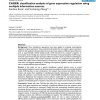Free Online Productivity Tools
i2Speak
i2Symbol
i2OCR
iTex2Img
iWeb2Print
iWeb2Shot
i2Type
iPdf2Split
iPdf2Merge
i2Bopomofo
i2Arabic
i2Style
i2Image
i2PDF
iLatex2Rtf
Sci2ools
BMCBI
2005
2005
CAGER: classification analysis of gene expression regulation using multiple information sources
Background: Many classification approaches have been applied to analyzing transcriptional regulation of gene expressions. These methods build models that can explain a gene's expression level from the regulatory elements (features) on its promoter sequence. Different types of features, such as experimentally verified binding motifs, motifs discovered by computer programs, or transcription factor binding data measured with Chromatin Immunoprecipitation (ChIP) assays, have been used towards this goal. Each type of features has been shown successful in modeling gene transcriptional regulation under certain conditions. However, no comparison has been made to evaluate the relative merit of these features. Furthermore, most publicly available classification tools were not designed specifically for modeling transcriptional regulation, and do not allow the user to combine different types of features. Results: In this study, we use a specific classification method, decision trees, to mode...
| Added | 15 Dec 2010 |
| Updated | 15 Dec 2010 |
| Type | Journal |
| Year | 2005 |
| Where | BMCBI |
| Authors | Jianhua Ruan, Weixiong Zhang |
Comments (0)

